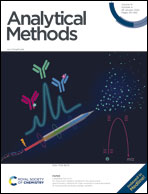LC-HRMS studies on ruxolitinib degradation: a comprehensive approach during drug development†
Abstract
Ruxolitinib, a kinase inhibitor, was subjected to stress studies as described in the ICH Q1A(R2) guidelines. Solution state hydrolytic and solid state oxidative and thermal stress studies were carried out to understand its degradation behaviour. The drug showed significant instability in the hydrolytic condition in comparison with other conditions. HPLC and UHPLC methods were developed for the separation of the drug and its hydrolytic degradation products. Mass fragmentation pathway of the drug was established as the first step of the LC-MS characterization of the degradation products. MS/MS analysis of the drug and MS3 of selected fragments were achieved through QTOF and QTRAP by varying the collision energy and performing an H/D exchange. LC-MS/MS QTOF studies were subsequently carried out on stress samples and the structures of the degradation products were identified through comparison of the drug fragmentation pathways. The four hydrolytic products viz. 4-(1H-pyrazol-4-yl)-7H-pyrrolo[2,3-d]pyrimidine, 3-(4-(7H-pyrrolo[2,3-d]pyrimidin-4-yl)-1H-pyrazol-1-yl)-3-cyclopentylpropanoic acid, 3-(4-(7H-pyrrolo[2,3-d]pyrimidin-4-yl)-1H-pyrazol-1-yl)-3-cyclopentylpropanamide, and 3-(4-(6-amino-5-formylpyrimidin-4-yl)-1H-pyrazol-1-yl)-3-cyclopentylpropanenitrile were formed under acidic and basic conditions. The degradation pathway was delineated through a mechanistic explanation. The in silico tools preADMET and Protox-II predictor were used to compare the toxicity of the impurities with respect to the drug.



 Please wait while we load your content...
Please wait while we load your content...